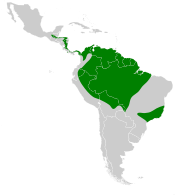Nyctibius
| Nyctibius | |
|---|---|

| |
| Common potoo (N. griseus) | |
| Scientific classification | |
| Domain: | Eukaryota |
| Kingdom: | Animalia |
| Phylum: | Chordata |
| Class: | Aves |
| Clade: | Strisores |
| Order: | Nyctibiiformes |
| Family: | Nyctibiidae |
| Subfamily: | Nyctibiinae |
| Genus: | Nyctibius Vieillot, 1816 |
| Type species | |
| Caprimulgus grandis (great potoo) Gmelin, JF, 1789
| |
| Species | |
|
See text | |
Nyctibius is a genus of potoos, nocturnal birds in the family Nyctibiidae.
Etymology
[edit]The genus Nyctibius was introduced in 1816 by the French ornithologist Louis Pierre Vieillot to accommodate a single species, Comte de Buffon's "Le Grande Engoulevent de Cayenne", the great potoo, which thus becomes the type species.[1][2] The genus name is from Ancient Greek nuktibios meaning "night-feeding", from nux night and bios "life".[3]
Distribution
[edit]They are found throughout much of Mexico, Central America, South America, and parts of the Caribbean.[4]
Taxonomy
[edit]They are one of two genera in the family, the other being the monotypic genus Phyllaemulor (containing only the rufous potoo). Prior to 2018, they were considered the only extant genus within the Nyctibiidae; however, a study that year found a deep divergence between the rufous potoo and all other species in the genus, leading it to be described in a new genus and expanding the number of genera within the family.[5] This was followed by the International Ornithological Congress in 2022.[6] The genus Nyctibius contains six species:[4]
| Common name | Scientific name and subspecies | Range | Size and ecology | IUCN status and estimated population |
|---|---|---|---|---|
| Great potoo | Nyctibius grandis (Gmelin, 1789) |
southern Mexico through northeastern Guatemala and through most of Central America down through South America as far as southeastern Brazil and Bolivia.
|
Size: Habitat: Diet: |
LC
|
| Long-tailed potoo | Nyctibius aethereus (Wied-Neuwied, 1820) |
from Ecuador and Peru east through southern Colombia and Venezuela to the Guianas, in far northern Bolivia, northeastern Argentina, southeastern Paraguay, and southeastern Brazil
|
Size: Habitat: Diet: |
LC
|
| Northern potoo | Nyctibius jamaicensis (Gmelin, 1789) |
across Central America and the Caribbean.
|
Size: Habitat: Diet: |
LC
|
| Common potoo or lesser potoo | Nyctibius griseus (Gmelin, 1789) Two subspecies
|
Caribbean plain of Colombia
|
Size: Habitat: Diet: |
LC
|
| Andean potoo | Nyctibius maculosus Ridgway, 1912 |
Bolivia, Colombia, Ecuador, Peru, and Venezuela
|
Size: Habitat: Diet: |
LC
|
| White-winged potoo | Nyctibius leucopterus (zu Wied-Neuwied, 1821) |
Brazil, French Guiana, Guyana, Peru, Suriname, and Venezuela
|
Size: Habitat: Diet: |
LC
|
References
[edit]- ^ Vieillot, Louis Pierre (1816). Analyse d'une Nouvelle Ornithologie Élémentaire (in French). Paris: Deterville/self. p. 38.
- ^ Peters, James Lee, ed. (1940). Check-List of Birds of the World. Vol. 4. Cambridge, Massachusetts: Harvard University Press. p. 179.
- ^ Jobling, James A. (2010). The Helm Dictionary of Scientific Bird Names. London: Christopher Helm. p. 277. ISBN 978-1-4081-2501-4.
- ^ a b Gill, Frank; Donsker, David; Rasmussen, Pamela, eds. (January 2022). "Frogmouths, Oilbird, potoos, nightjars". IOC World Bird List Version 12.1. International Ornithologists' Union. Retrieved 8 July 2022.
- ^ Costa, Thiago V. V.; Whitney, Bret M.; Braun, Michael J.; White, Noor D.; Silveira, Luís Fábio; Cleere, Nigel (2018-04-01). "A systematic reappraisal of the Rufous Potoo Nyctibius bracteatus (Nyctibiidae) and description of a new genus". Journal of Ornithology. 159 (2): 367–377. doi:10.1007/s10336-017-1511-2. ISSN 2193-7206. S2CID 4524359.
- ^ "Nightjars, Oilbird, potoos, frogmouths – IOC World Bird List". Retrieved 2022-08-25.






